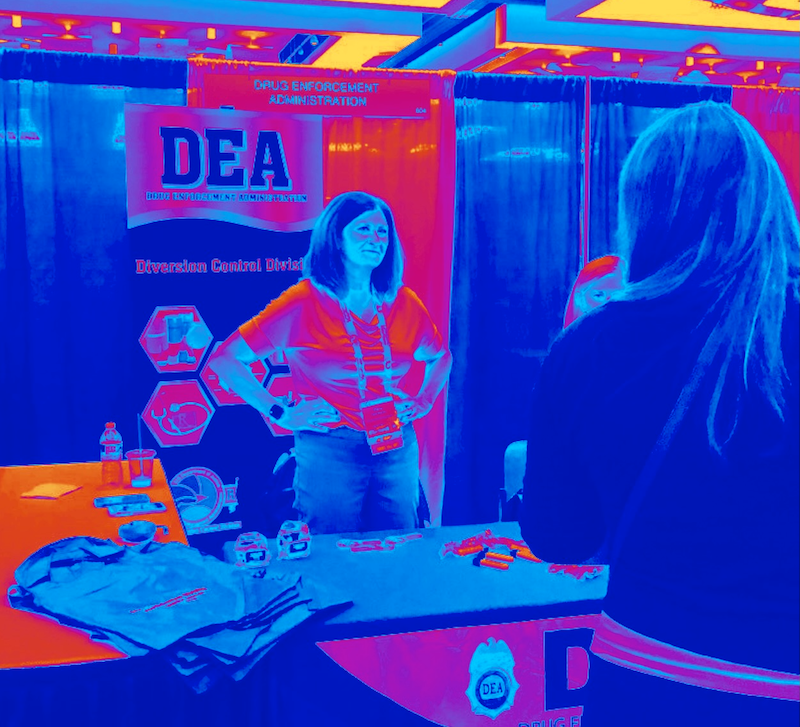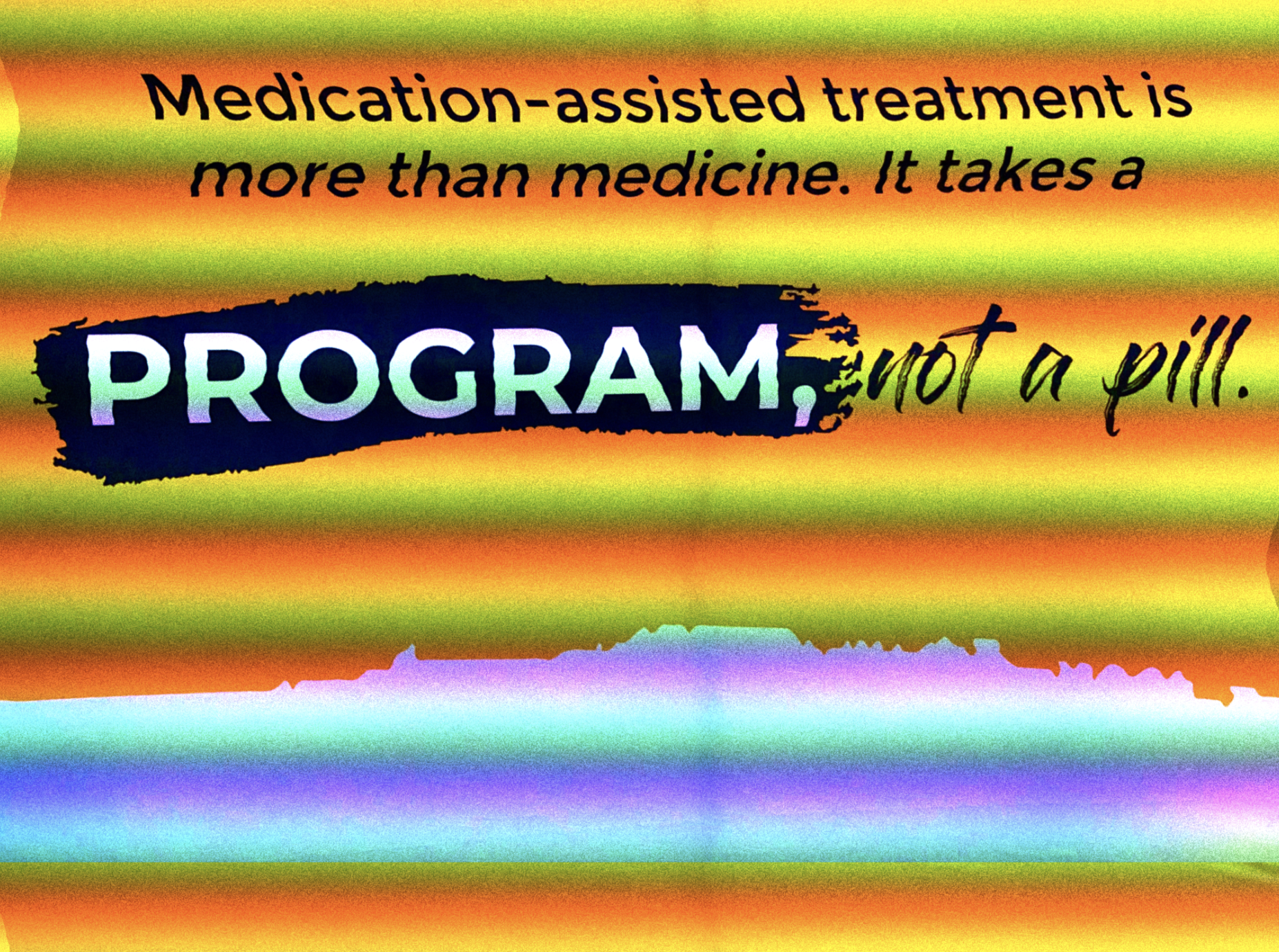Attending the American Association for the Treatment of Opioid Dependence (AATOD) conference, held in Baltimore this month, felt like being behind enemy lines. AATOD is the principal organization representing opioid treatment programs (OTPs, or methadone clinics) across the United States.
As bad as the event was, and it was really bad, it was clarifying. In dozens of meetings, some featuring top officials from the Substance Abuse and Mental Health Services Administration (SAMHSA) and other federal agencies, there was no sense that something is fundamentally broken in the OTP system or that real reform is urgently required to save lives.
“DEAATOD”
What became crystal clear during panels, plenaries and conversations with exhibitors was the enduring importance of ATTOD’s relationship with the Drug Enforcement Administration (DEA). The DEA, which has been waging a racist international drug war for over 50 years, has always played a central role in the regulation of OTPs. The agency’s warped priorities have created an inhumane, carceral-medical methadone dispensing system that criminalizes patients and keeps them chained to the clinic indefinitely. AATOD doesn’t have a problem with any of that.
“The DEA is a wonderful partner.”
“The Power of Collaboration” was the theme of the conference. Mark W. Parrino, the indefatigable and irascible founder and president of AATOD, loves to collaborate with the DEA. At every annual conference, a DEA official is a keynote speaker. “The DEA is a wonderful partner,” Parrino said in the opening plenary.
He thanked the agency for lifting the 15-year ban on mobile methadone vans. Wow! I wonder how many lives could have been saved if there had never been a ban. In contrast, Portugal has deployed methadone vans since 2001.
In the closing plenary, Parrino shared the stage with Kristi N. O’Malley, the assistant administrator of the DEA’s Diversion Control Division, to opine on “The Present and Future of Federal Regulations for Opioid Treatment.” He stated emphatically, while glancing approvingly at O’Malley, “We work with the DEA and we don’t have a problem with regulation.”
O’Malley’s speech was a master class in misinformation. She stated that the DEA is committed to expanding access to life-saving medication and not disrupting patient care. If that’s true, why is it easier to get fentanyl on the street than to get methadone or buprenorphine? And why do approximately 86 percent of people with opioid use disorder (OUD) not receive medication?
With a hint of annoyance in her voice, O’Malley addressed the issue of pharmacies refusing to stock buprenorphine and access issues for patients, especially in rural areas. “The DEA doesn’t place caps on how much buprenorphine can be ordered,” she said. “We want to make sure there is an adequate supply.” She denied that the problem has anything to do with DEA raids of pharmacies that fill a lot of Suboxone prescriptions.
But it has everything to do with what O’Malley euphemistically called “law enforcement actions.” According to Steve Hylton, an independent pharmacist, the DEA “has come down hard against buprenorphine despite publicly supporting medication-assisted treatment,” reported the Virginia Mercury. In addition, dozens of prescribers of OUD medication have been targeted by the DEA and other law enforcement agencies across the country.
In response to O’Malley’s remarks, Parrino said, “The DEA is not in the way of people getting care.” The gaslighting was astounding. I was waiting for someone in the audience to challenge it. No one did. The closing plenary ended with a raffle.
The truth is, OTPs need the DEA’s strict regulations to stay in business—they guarantee a captive group of powerless patients in perpetuity. I have interviewed people who’ve attended a clinic weekly for over 20 years. “You never really graduate from this,” one clinic counselor told me.
A workshop at the conference, “Effectively Treating the Aging and Elderly in Opioid Treatment Programs: A Comprehensive Model,” acknowledged this depressing reality. OTPs have a methadone cartel because of the DEA. Control of the system benefits the DEA, too. OTPs are low-hanging fruit for the drug warriors. It’s easier to threaten clinics with license revocation, probation, or closure over one missing, empty bottle of methadone than it is to find fentanyl in a billion shipping containers. When armed DEA agents conduct a random, unannounced visit at an OTP because they suspect “diversion” or inventory errors, they’ll meet no resistance or return fire, just terrified staff. These raids, which garner positive media coverage, make the DEA look like it’s actually doing something to end the overdose crisis, when nothing could be further from the truth.
The DEA regulates the manufacture and distribution of controlled pharmaceuticals and seeks to stop the supply of illicit drugs. Its approach has failed spectacularly through wave after wave of the overdose crisis, from OxyContin to heroin to fentanyl. Crackdowns and prohibition have led to more than 932,000 people dying of an opioid-involved overdose since 1999. “It’s time to abolish the DEA,” Kassandra Frederique, executive director of the Drug Policy Alliance (DPA), said in an interview with Truthout. For AATOD to ignore the carnage and “collaborate” with the drug warriors who cause it is a travesty.
“We are trying to help; we believe in methadone.”
There was a DEA booth in the cavernous exhibit hall, staffed by two women. The blue and white banner declared, “DEA – Diversion Control Division.” Swag on the table included pens, plastic paper clip holders, mini screwdriver kits and blue bags. I walked over to pick a fight, saying that the police agency has no business being involved in methadone and should get out.
“We’re not going anywhere,” one of the women shot back, with a curt smile. “We don’t get involved in how methadone clinics operate.”
The other said, nice as pie, “We are trying to help; we believe in methadone.” Then she showed me a QR code on her phone and said I could download the DEA guide to OTP regulations. FOH!

Resisting the Tide of Reform
The leadership of AATOD is running scared. They know change is inevitable and that their stranglehold over methadone could end. COVID-19—the only reason that reform is being discussed at the national level—forced OTPs to relax regulations for the first time. Overnight, far more people became eligible for 14 or 28 days of take-home bottles, and some clinics reduced or eliminated urine testing and cut back on mandatory counseling sessions. For thousands of oppressed patients, the pandemic liberated them. The “liquid handcuffs” were finally taken off!
“Finally, my prescribed medication was being treated like a prescribed medication,” one patient, who got 28 days of take-homes, wrote for Filter. “It also offered the freedom to travel for the first time without the panic of getting clinic approval.”
Why wasn’t there a plenary called “The Power of the Pandemic,” featuring only methadone patients? Because AATOD doesn’t want to examine the profound, positive impact of COVID relaxations, exposing its own punishing practices and its lies about the need for strict regulations.
The panel, “OTP Basics for Non-OTP Professionals,” included one token person with lived experience, who made no criticism of the clinic system. But to my surprise, another panelist did: Kenneth B. Stoller, a doctor at a clinic in Baltimore and an AATOD board member, voiced mild criticism when he stated, “OTPs are in a parental position,” and “When take-home bottles are taken away, dignity is lost.”
No doubt Volkow’s comments sent ATTOD into panic mode, because that is its worst fear: patients getting methadone outside the profitable confines of clinics.
The call to enact fundamental reform keeps getting louder. Nora Volkow, the director of the National Institute on Drug Abuse, said at a STAT Summit this month that American doctors should “absolutely” be allowed to prescribe methadone directly to patients. “Methadone is underutilized in part because it requires such stringent conditions in order to be prescribed,” she said. The normally conservative Volkow then went nuclear by advocating for pharmacists to dispense methadone to patients in consultation with a physician.
No doubt her comments sent ATTOD into panic mode, because that is its worst fear: patients getting methadone outside the profitable confines of clinics. Kiss the cartel goodbye!
There was even sentiment among some conference attendees that change was desperately needed. “We have to remove barriers to care. Reducing clinic restrictions is about getting life-saving medication to people without them having to jump through hoops,” John Hamilton, the whip-smart, fast-talking CEO of Liberation Programs told Filter. “Only one in 10 are interested in getting treatment because I don’t think it’s attractive to people because there are all these arbitrary restrictions. I’m opposed to these restrictions.”
But there is no doubt that AATOD, in collaboration with the DEA, will fight to maintain control of methadone by any means necessary, including fear-based messaging and misinformation.
On the panel “MAT Policy, Advocacy and Reform: Being a Voice in a Time of Change,” two AATOD board members laid out a strategy to block legislative reform. The first, Jason Kletter, is the president of BayMark Health Services. The for-profit corporation has bought up OTPs around the country and continues to open new ones. Kletter’s PowerPoint presentation was a series of snarky and contradictory claims about harm reduction, and a rebuke to people who want to deregulate methadone. He said that OTPs strike a critical balance between the extreme ends of the treatment debate, abstinence on one end and harm reduction on the other. Kletter didn’t explain how harm reduction is “extreme,” but went on to praise it for saving lives. “OTPs are the original harm reduction service,” one of his slides asserted.
Methadone is harm reduction, but the clinic system Kletter profits from is a system of harm production. The culture of cruelty, as described in the Methadone Manifesto, exists in every OTP and creates myriad harms, driving people out of treatment and increasing the risk of death. Then the patronizing BayMark president showed a slide that read:
Smart, well-intentioned people are conflating harm reduction and treatment, suggesting things like:
* medication alone is treatment
* counseling is ineffective/unimportant
* drug testing is a barrier to access
* supervised dosing is oppressive
But it’s Kletter who is mistaken. All those things are true.
Calling It Harm Reduction
OTP staff have adopted the language of harm reduction, in particular, “come as you are” and “meeting people where they’re at.” Their promotion of these ideas reflected cognitive dissonance, when clinic staff have absolute, unchecked power over patients, demanding adherence to rigid clinic rules and abstinence from all other drugs, even alcohol and cannabis. Dignity, autonomy and respect? No. If a patient has a positive urine test, is late, loiters, is behind on paying fees, or misses groups, they’re punished. That isn’t meeting people where they’re at. It’s the opposite of harm reduction.
It’s commendable that some staff want patients to have on-site access to sterile syringes. But that doesn’t change the fact that clinics are carceral institutions.
There were four conference meetings with “harm reduction” in the title. More confusion ensued during “Does Harm Reduction Help or Hurt Individuals with an OUD?” How is this even a question in 2022? The speakers, a nurse and a recovery support specialist, advocated for syringe provision in OTPs. “Dead people can’t recover,” they said. The two promoted “safety first,” another harm reduction-based idea. They also highly recommended to the audience, “Getting Off Right: A Safety Manual for Injection Drug Users” created by the National Harm Reduction Coalition.
It’s commendable that some staff on the frontlines of OTPs want patients to have on-site access to sterile syringes. But that doesn’t change the fact that clinics are carceral institutions that deny patients basic rights.
AATOD has doubled down and attacked legislation that would liberate methadone patients. Chrissie Martin, a licensed marital and family therapist, outlined why the group opposes the Opioid Treatment Access Act. The main reason is that it would allow doctors outside OTPs to prescribe up to one month of methadone to patients, who could pick it up at a pharmacy. The legislation only permits a limited group of physicians trained in addiction medicine to prescribe methadone.
To sow fear and doubt, Martin talked safety. “While the strict regulatory frameworks at the federal and more markedly, state regulatory frameworks can contribute to an environment within the OTP that can feel onerous to the patient experience, we must also acknowledge that this framework creates an important safety net for both patients and communities,” Martin said. “In our zeal to improve the accessibility of treatment, we must not implement changes at the expense of safety.”
Can feel onerous to the patient experience? Martin clearly hasn’t had the experience of being a patient at an OTP, making a four-hour roundtrip six days a week, year after year, and subjected to the terror of losing take-home bottles because she ate a poppy seed bagel! The dismissal of the hardships people on methadone suffer is disgusting.
Then Martin bashed pharmacy dispensing. The person picking up the methadone might not be the patient, she warned; pharmacists won’t know the patient’s medical history and don’t have training to recognize signs of deterioration or intoxication.
OUD patients in Australia and the UK have long been able to pick up methadone from pharmacies.
This is pure fear-mongering. Patients pick up methadone to treat pain at pharmacies, as well as other synthetic opioids. OUD patients in Australia and the UK have long been able to pick up methadone from pharmacies. Pharmacists do understand the pharmacology of methadone—it’s been prescribed for over 40 years. Moreover, they’re trained to identify drug interactions, advise on side effects, and monitor medication safety issues.
Martin then moved on to criticize the Mainstreaming Addiction Treatment Act, which would eliminate the buprenorphine-prescribing “X-waiver” and the caps on the number of patients providers can treat. AATOD opposes the legislation.
Hamilton, who supports it, told Filter, “In France we saw the difference once all physicians were able to prescribe buprenorphine. There was a significant reduction in deaths.”
Counseling and Coercion
Martin was also perplexed that there’s been pushback against counseling in OTPs as a condition to receive methadone. She argued that therapy increases the efficacy of treatment. I support voluntary therapy outside of the clinic. But research shows no increase in positive outcomes or program retention in methadone patients who received counseling versus those who did not. Other research shows that medication is what keeps people in treatment, not therapy. Part of the problem is OTP counselors have little training or supervision.
“I strongly oppose the counseling mandate, not just because the services clinics provide are inferior, offered by untrained people and not evidence-based, but because within that setting you cannot offer anything legitimately therapeutic,” Danielle Russell, who has taken methadone for over a decade, told Filter. “‘Counseling’ is surveillance, nothing more. The ‘counselor’ at my last clinic, where I paid out of pocket, was the clinic accountant, and my “counseling” consisted of them asking if I had paid or not. Now I’m a client at a clinic owned by an AATOD board member. There is someone they refer to as my counselor, but the name has changed so frequently I’m not even certain I have ever met with them.”
“Sometimes they resist in the beginning because they think they don’t need it.”
I heard a lot about the need for counseling in OTPs at the conference. AATOD’s leaders have pressed the issue in an attempt to take the spotlight off their abject failures and rebrand themselves as warm, fuzzy, good samaritans. To that end, they employ empty catch phrases to describe what OTPs offer: “patient-centered care,” “comprehensive care,” “whole-patient approach,” and “medication-assisted treatment is more than just medicine.” To get this message out, AATOD launched “Program, not a pill.” The campaign is funded by BayMark Health Services, the Behavioral Health Group and other for-profit corporations.

Back in the exhibit hall I visited the bright orange “Program, not a pill” booth and spoke with the two women staffing it. They work for Cura Strategies, a health care communications and public relations firm that developed the campaign. I introduced myself as a journalist and a licensed clinical social worker who has worked in the field for over two decades. Using talking points from Martin’s presentation, one of the women, Erin, explained that successful recovery involved both medication and behavioral therapy.
She’d talked to many clients who “love counseling,” she said. “Sometimes they resist in the beginning because they think they don’t need it.”
I countered with my interviews with numerous people who resented being told they had to have therapy. They also shared that they almost never told their counselors the truth, especially if they were still using drugs, because they feared punishment.
Erin ignored that and stated, “Why not increase counseling if a person relapses?” It became apparent during our conversation, which was amicable, that neither woman understood the implications of the power differential between OTP counselor and client—which makes a true therapeutic alliance, based on freedom and honesty, impossible.
I asked Hamilton, who is also a licensed marital and family therapist, about his position on mandated counseling. “Here is the harm: If you give people more treatment than they want, it can drive them out because they’re not committed to it,” he said. “I’m a big proponent of saying medication is better than nothing at all … We have to do whatever it takes to keep people alive during this fentanyl epidemic.”
If only AATOD believed that.
Photographs by Helen Redmond
The Influence Foundation, which operates Filter, previously received a restricted grant from DPA to support a Drug-War Journalism Diversity Fellowship.




